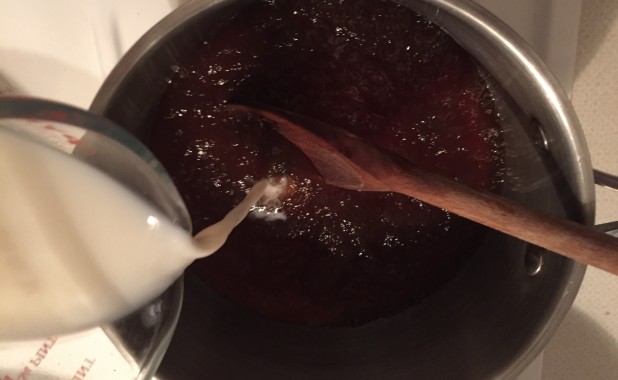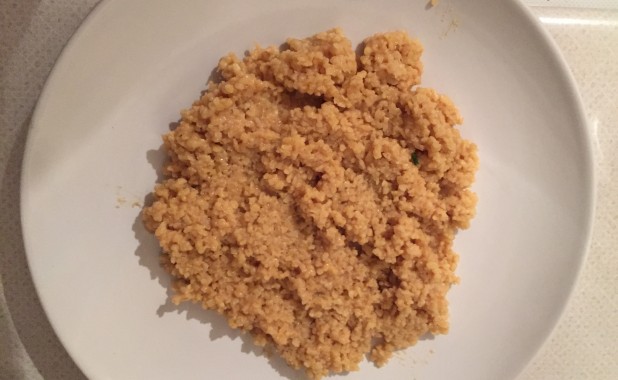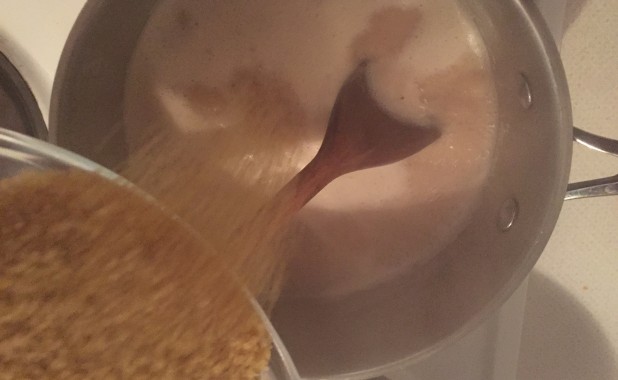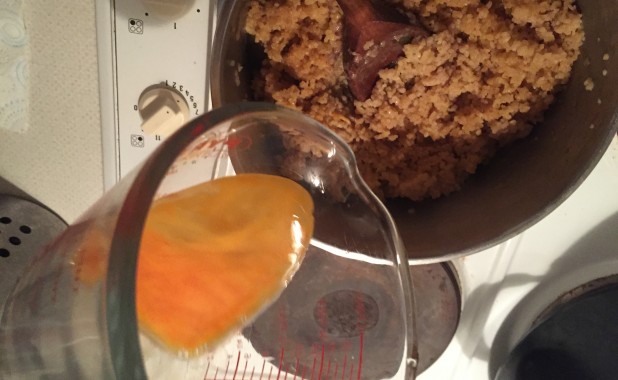So, for a while I’ve been promising myself I’d have a go at making frumenty. For a start, it’s easy, and also, it’s ubiquitous. It was a very common thing to serve in medieval times. Potages, or simple meals of grain or vegetables, were something all levels of society took part in. It’s a more rewarding research project to cook commoner food than the dishes that would have gone on to feed the elite. You’re exploring a more universal experience of what it was like to live in those times.
Anyway, as for frumenty itself, it is a kind of cracked wheat or barley porridge, the savoury kind being made with stock and sometimes mixed with milk. This could be cow or almond milk, depending on whether it was to be served on a fast day or not. This version is coloured with a dab of saffron and bound with an egg. Frumenty is derived from frumentum, the Latin for wheat. It is served with most meats, but especially with venison. To medieval people, venison and frumenty are like fish and chips and sausage and mash.
This particular version included saffron, though Wikipedia claims that a sweet version of this, with currants, is still made in Devizes on Mothering Sunday. Another sweet version, called “furmity” and served with a slug of rum, is referred to in Hardy’s The Mayor of Casterbridge.
However, this time I’m going to be making a savoury frumenty with beef stock and milk. And I’ll be serving it with its good buddy of old – venison (I’ll talk more about the venison next post).
The recipe is another one from the Forme of Cury, dated about 1390:
Nym clene wete & bray it in a morter wel, that the holys gon al of, & seyt yt till yt breste; & nym yt up & lat it keel. And nym fayre fresch broth & swete mylk of almandys or swete mylk of kyne and temper yt al. & nym the yolkys of eyryn & saffron & do therto. Boyle it a lily & set yt adorn, & messe yt forthe with fat venysoun & fresch motoun.
Take clean wheat and break it up in a mortar, so the hulls come off, and cook it till it plumps up and bursts and then drain it and let it cool. Make fresh broth and sweet milk (either cow or almond) and mix everything together, and then add egg yolks and saffron. Boil it a little and serve it with fat venison or fresh mutton.
Fat venison, I got you covered.
But to make the frumenty, I did this:
Ingredients for Frumenty
- 200g bulgur wheat
- 500ml stock
- 200ml milk
- pinch saffron
- 1 egg, beaten
It’s dead easy, particularly since you don’t have to spend hours mortar and pestle-ing your wheat and then boiling it in our modern age – you just buy a bag of bulgar wheat.
First, mix your stock and milk together in a saucepan:

I used the Heston Blumenthal stock from Waitrose, which was lovely and came in a jelly form. I went with dairy milk for this, but you could use almond milk, or even replace the milk with more stock. The final effect is this very rich, eggy, porridgey thing though, so the milk felt right ultimately, weird as it was to cook.
Anyway, bring it to the boil, and then chuck your bulgur wheat in:
Add a tiny pinch of saffron – about five strands. You’re after the colouring rather than the flavour.
Once it’s boiling again turn the heat way, way down and cover it, and let it not so much simmer as settle for about 30 – 50 minutes. Well, Hiatt and Butler recommended this, but I found it was done in about twenty-five minutes.
Make sure to top up the liquid with water or stock if it looks like it’s getting too dry. You are not looking for bite, like in pasta, but for it to be soft but not completely squishy. I was serving this with a meat dish that had its own sauce, so I didn’t want it to be too moist.
Next, add your beaten egg:
Pop it back on the low heat and mix the egg through it. You’re not looking to cook the egg, I don’t think (so this dish is neither pasteurised nor Kosher. Sorry.) so much as add a kind of yolky richness to the texture, so the egg can’t be solid or crumbly.
And you’re done:
You’ll have noticed during the tasting no doubt that there’s no seasoning. That’s okay, because all of this is is a foil to the highly seasoned thing I will be serving with it. More on that anon…
Is it nice?
On its own? It’s tough to describe without spoilers, but yeah, it’s all right. More than pasta, bread, or rice, it’s something that exists to support other food. The extra things, like stock and milk and egg, all tend to come into their own when counter-balanced with the highly flavoured sour, sweet sauces and gamey meats that medieval cookery seems to love. It has a yolky, buttery, soft texture and when you put it on your tongue, you have this distinct sense it’s a matrix crying out for other flavourings. The meat juice I added was not particularly strong-tasting, but that could have been the absence of any salt being added.
That said, you wouldn’t need to cook expensive meat to go with it to make this a nice sturdy tea. It would take any flavour and be a tasty filling dish – you could add boiled eggs, or cut up sausage or bacon, or veg and herbs, especially if you added some crucial salt and a bit of pepper to it. It put me in mind of those couscous dishes I ate while digging in Tunisia, which came dry and had various added ingredients like chicken legs semi-submerged in it. Anything you had spare in the fridge would do, and you’d end up with a good, rib-sticking meal.
It would also work well in the sweet form, with currants and sweet spices and possibly cream, though in that case I would serve a much wetter version, more like a pudding.
So basically… yeah. Yeah. But it needs something to complete it. And that’s the story of the next post.




